Ukraine’s power supply problems caused by Russian airstrikes have at least one positive side for astronomers — a true dark starry sky has once again appeared over our cities. Many remarkable objects are visible to the naked eye, and we strongly advise those who are just starting to get acquainted with astronomy to devote some time to their search. So what interesting things can be seen over Ukraine on New Year’s Eve?
Sirius. Among the “fixed stars”, as ancient astronomers called them, the brightest one is Sirius — α of Canis Major. It is not just a “first-magnitude star”: its brightness is expressed as a negative value (-1.47ᵐ). Among other celestial objects, only the Sun, Moon, Venus, Jupiter, and sometimes Mercury and Mars surpass it by this indicator. Some supernovae also brightened briefly, but then faded. For almost a hundred thousand years, Sirius has remained the brightest celestial body that does not belong to the Solar System. It owes this not least to the fact that it is one of the three closest star systems: it is 8.6 light years away from us. Moreover, now it is almost at the minimum possible distance and will begin to drift away from us in a couple of thousand years.
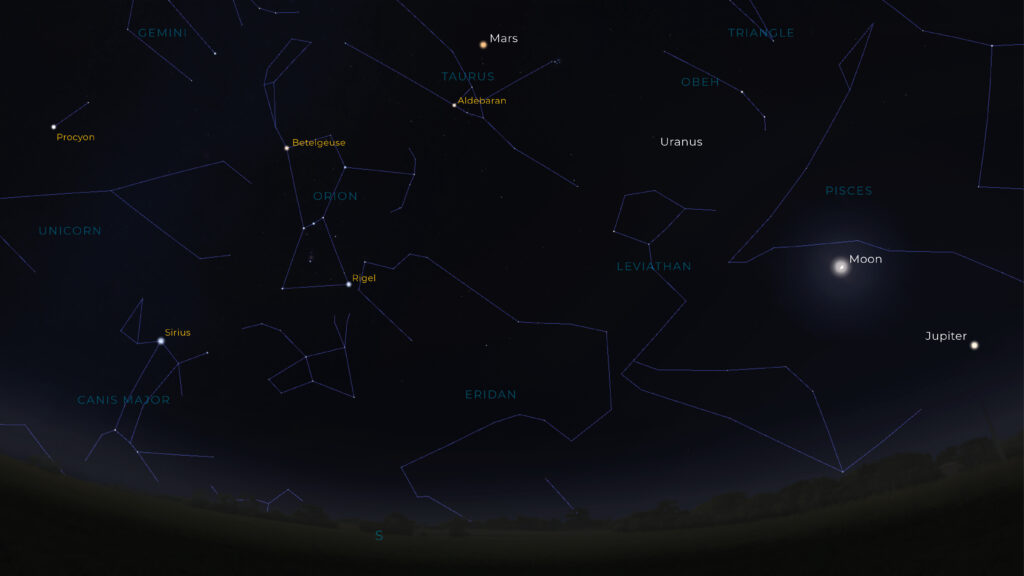
On December 31, in our latitudes, Sirius rises at approximately 8 pm. Once it rises a little above the horizon, it is hard not to pay attention to it. Due to the “intervention” of the Earth’s atmosphere, the bright star flickers strongly and, moreover, changes color noticeably, inducing most sensitive observers to think of “flying saucers”. It is interesting that the upper culmination of Sirius at midnight in our era occurs precisely on January 1 — in such an interesting way it “marks” the beginning of the calendar year. The brightest star has a faint satellite of 8th magnitude. This is the first white dwarf known to mankind.
Orion constellation. Sirius is part of the so-called “winter triangle”. Its other two “corners” are Procyon (α Canis Minor) and Betelgeuse, the second brightest star in the Orion constellation. Despite this, it is marked with the Greek letter “alpha”, and the brighter Rigel, which has approximately zero magnitude, with the letter “beta”. Betelgeuse has a distinctive reddish color. It changes its brightness and can occasionally become brighter than Rigel, “justifying” its letter designation.
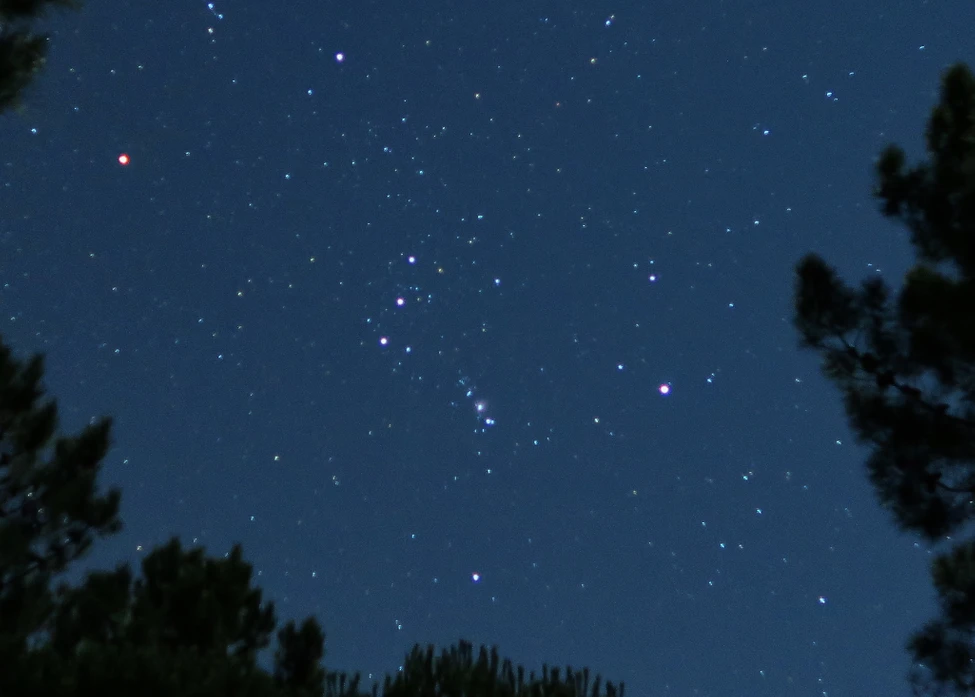
Both of these stars are located in opposite “corners” of Orion’s characteristic rectangular shape. In the middle, this rectangle is crossed by an almost straight line of three rather bright stars – the so-called “Orion’s Belt”. Now this constellation is equally well visible in both hemispheres of the Earth, but in 10 thousand years from the latitude of Kyiv, only its northern part will be visible together with the star Betelgeuse; the southern one, including the Rigel and belt, will never rise above the horizon. Now, on the territory of Ukraine, Orion rises at approximately 6 o’clock in the evening local time and remains in the sky almost until dawn. The beginning of January is the most favorable time to observe it.
The Orion Nebula. One of the remarkable details of the Orion constellation is worth special attention. It is easy to see with the naked eye south (below) Orion’s Belt, where three more faint stars are located — the Orion`s Sword. The middle one is surrounded by a clearly visible light “cloud”. This is the glorious Orion Nebula, or rather, its brightest part.
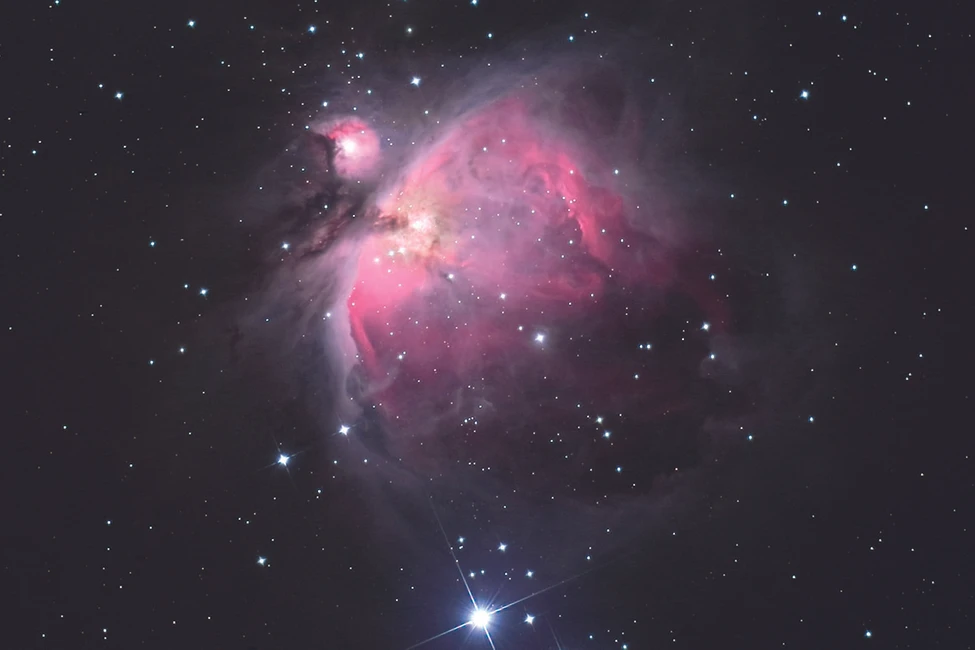
We now know that this nebula is a huge condensation of interstellar hydrogen, which is getting compressed under the influence of its own gravity, due to which new stars are constantly being born there. So, this is the brightest area of star formation in the Earth’s sky. The distance to it is estimated at 1350 light years. It has a diameter of about 1° (twice as large as the disk of the full Moon), which corresponds to a linear size of 24-25 light years. The nebula is “illuminated” by the powerful radiation of hot massive luminaries less than a million years old, which is very little by the standards of the universe. The total mass of its matter is enough to form more than two thousand stars like the Sun. French astronomer Nicolas-Claude de Peiresc, who saw it through one of the first telescopes on November 26, 1610, is considered discoverer of this object.
Pleiades and Hyades. Two more interesting objects can be seen in the constellation Taurus, bordering Orion to the north. These are the brightest star clusters in the Earth’s sky — the Pleiades (its Ukrainian name is Stozhary) and the Hyades. The former them is hard to miss: its brightest stars form a tight group that resembles a small ladle by shape (which is why some mistakenly call them “Ursa Minor”). Although it seems small, the Moon, which passes through the Pleiades from time to time, is not able to cover them completely. In fact, the cluster includes more than a hundred luminaries approximately 100 million years old, scattered over a region of the celestial sphere with a diameter of almost 2°. According to the latest data, the distance to its center is 444 light years.
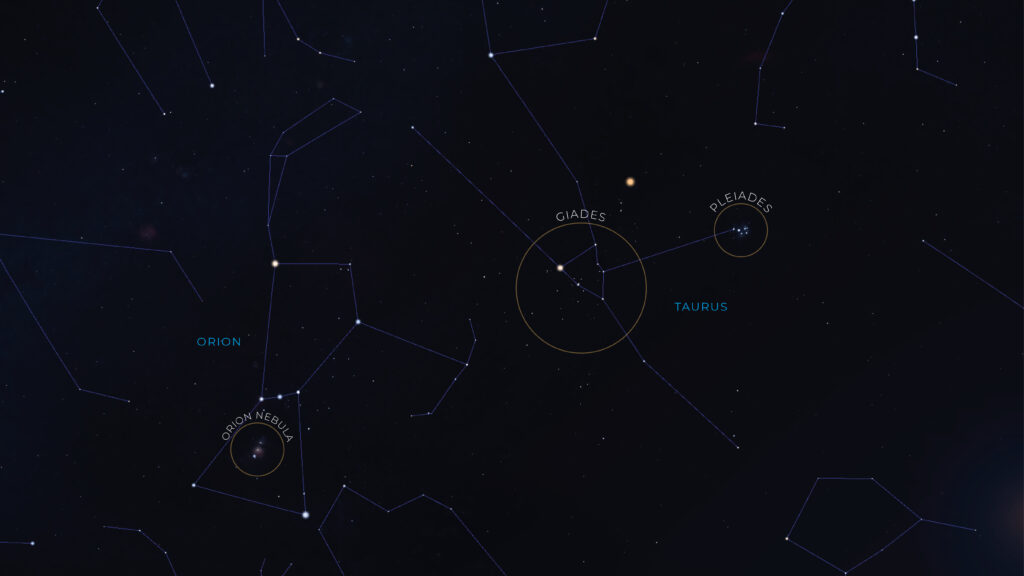
The center of the Hyades is located much closer — at a distance of 153 light years. Therefore, this cluster looks more “stretched”, occupying an area in the sky with a diameter of more than 6°, and in space — a sphere with a diameter of 9 light years. But recently it became known that this is only the largest concentration of the “stellar swarm”, the total mass of which actually exceeds 400 solar masses, and it forms an elongated strip stretching from the constellation Orion almost to Cassiopeia. The bright orange Aldebaran (α Taurus), which is 65 light-years away from us, is accidentally projected onto its central part. The age of the Hyades exceeds 600 million years.
Parade of outer planets. All previous celestial objects are “permanent” — they can be observed every year. The planetary configuration in the December evening sky of 2022 is not observed every day. Some media have already called it a “parade of planets”, although this is incorrect from the point of view of astronomical terminology.
Yes, indeed, all 7 major planets of the solar system are now visible in the evening. But, first of all, Mercury and Venus are located in the sky not far from the Sun and soon after its sunset, they also hide behind the horizon. And secondly, the angular distance between the extreme points of the “planetary chain” — Mercury and Mars — will exceed 130°, which is too much for the “parade” (for it, the planets should be located in the ecliptic sector less than 90°). And even the outer planets at the end of December will “fit” into an arc measuring as much as 106°.
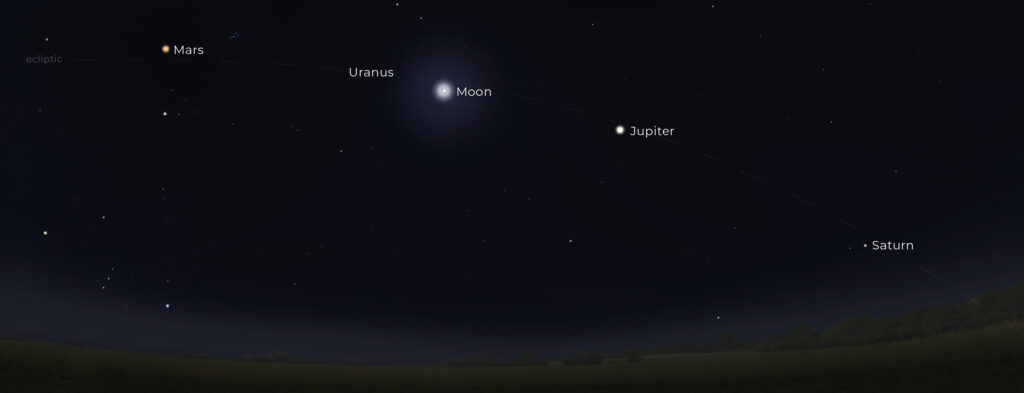
However, the very opportunity to see five planets at once is also a rare enough option. We recommend starting with Saturn — it will gradually descend over the southwestern part of the horizon and will have brightness slightly above the 1st magnitude, which will allow you to easily find it in the Capricorn constellation, where there are no such bright stars. It will be much easier to find Jupiter, which is currently the brightest star-like object in the night sky. On December 31, its position will be “hinted” by the Moon, which is located 28° to the left (eastwards). With a detailed star map, you can try to find Neptune, the farthest planet from the Sun, 8° west of Jupiter. But it will be possible to see it only by astronomical instruments (at least with small binoculars with a lens diameter of 30 mm).
If in the case of Jupiter, our natural satellite will help, then with Uranus it will hinder. You can try to see this planet in a very dark sky with the naked eye, but such a sky does not usually occur within 15° of the Moon in a phase greater than first quarter. Therefore, you will also need binoculars and a star map or a planetarium program to search for it. Finally, Mars will be visible in a clear sky just fine. It will be second in brightness to Jupiter and Sirius, but will differ from them in its distinctive reddish color. Though it can be confused with is the orange Aldebaran. On New Year’s Eve, Mars will be 8° north, but will be much brighter.
We wish our readers more clear nights and peaceful skies in the New Year!

